
The Marshan Palace is a palace of the King of Morocco in the Marshan neighborhood of Tangier, Morocco.

The Marshan Palace is a palace of the King of Morocco in the Marshan neighborhood of Tangier, Morocco.
The building was initially erected in the early 1950s as the seat of the Legislative Assembly of the Tangier International Zone. [1]
Following the independence of Morocco in 1956 and its proclamation as a kingdom on 14 August 1957, the building was repurposed as a property of the Monarchy. In the early years following independence, it was known as the Maison de Tanger ("House of Tangier"). [2]
From 27 to 30 April 1958, it was the venue of the Tangier Conference, a gathering of representatives from newly independent Morocco and Tunisia and from the Algerian National Liberation Front (FLN), which promoted a vision for a future united North Africa that unraveled in the subsequent years. Participants in the Tangier Conference included Ferhat Abbas, Abdelhafid Boussouf, and Abdelhamid Mehri from the FLN; Bahi Ladgham, Ahmed Tlili, and Abdelhamid Chaker from the Tunisian Neo Destour party; and Allal al-Fassi, Ahmed Balafrej, Abderrahim Bouabid, and Mehdi Ben Barka from the Moroccan Istiqlal Party. [3] The conference was chaired by Allal al-Fassi. [4]
In the 2010s, King Mohammed VI had the palace revamped to make it into a venue for diplomatic events. [5] On 20 September 2015, Mohammed VI and French President François Hollande made there a communication dubbed the "Tangier Call" (French : Appel de Tanger) about the need to fight climate change. [6]
Across the street from the Marshan Palace lies the Mendoub's Residence, the former mansion of the Mendoub (representative of the Sultan of Morocco in Tangier) that later hosted the Forbes Museum of Tangier from 1970 to 1990.

Mohammed al-Khamis bin Yusef bin Hassan al-Alawi, better known simply Mohammed V, was the last Sultan of Morocco from 1927 to 1953 and from 1955 to 1957, and first King of Morocco from 1957 to 1961. A member of the 'Alawi dynasty, he played an instrumental role in securing the independence of Morocco from the French and Spanish Protectorates.

Haj Muhammad Ben Abdessalam al-Muqri was a senior Moroccan official of the late 19th and early 20th century. He was an adviser and grand vizier to several sultans of Morocco, including under French colonial domination.

Tangier or Tangiers is a city in northwestern Morocco, on the coasts of the Mediterranean Sea and the Atlantic Ocean. The city is the capital of the Tanger-Tetouan-Al Hoceima region, as well as the Tangier-Assilah Prefecture of Morocco.
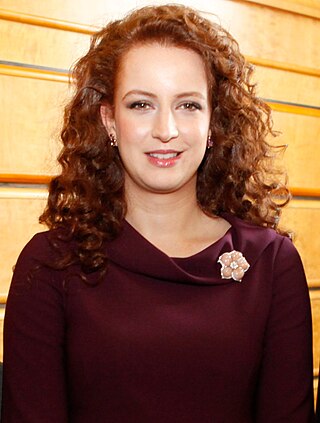
Princess Lalla Salma is the former wife of Mohammed VI of Morocco. They married in 2002, and she became the first wife of a Moroccan ruler to have been publicly acknowledged. She was last seen in an official capacity in December 2017, and it was later on reported, in 2018, that she and Mohammed VI had divorced.

Moulay Hassan is Crown Prince of Morocco. He is the elder child of King King Mohammed VI and Princess Salma. He has a younger sister, Princess Khadija. He is named after his grandfather Hassan II. Upon his accession, he is expected to bear the regnal name Hassan III. In 2013, he began participating with his father at public official engagements.
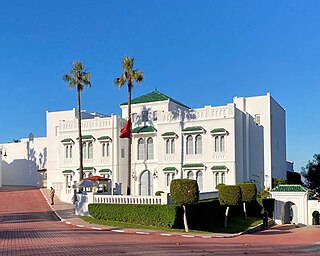
The Mendoub's Residence or Dar al-Mandub, formerly known as the Forbes Museum of Tangier, is a cultural monument and 10-acre (40,000 m2) property located on Mohammed Tazi Street in the Marshan neighborhood of Tangier, Morocco.

Ahmed Balafrej was the second Prime Minister of Morocco between May 12, 1958, and December 2, 1958. He was a significant figure in the struggle for the independence of Morocco.
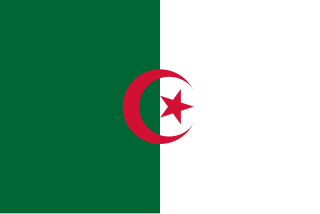
The Provisional Government of the Algerian Republic was the government-in-exile of the Algerian National Liberation Front (FLN) during the latter part of the Algerian War of Independence (1954–1962).

France–Morocco relations are bilateral relations between Morocco and France. They are part of the France–Africa relations.

The Tangier International Zone was a 382 km2 (147 sq mi) international zone centered on the city of Tangier, Morocco, which existed from 1925 until its reintegration into independent Morocco in 1956, with interruption during the Spanish occupation of Tangier (1940–1945), and special economic status extended until early 1960. Surrounded on the land side by the Spanish protectorate in Morocco, it was governed under a unique and complex system that involved various European nations, the United States, and the Sultan of Morocco, himself under a French protectorate. Due to its status as an international zone, Tangier played a crucial role for Moroccan Nationalists, who wanted independence, to establish international contacts and recruit allies as well as organising gatherings and events.
The Daniel Galván scandal was a political scandal in which Mohammed VI, the King of Morocco, issued a pardon for a Spanish convicted serial child rapist named Daniel Galván. The Spanish citizen was serving a thirty-year prison sentence. He was arrested in Morocco in late 2011, for having raped at least eleven Moroccan children in Kenitra, a city he had been living in since 2004. The pardon came some 18 months after his incarceration as part of a diplomatic gesture from Mohammed VI to Spain, on the occasion of the 14th anniversary of his enthronement.
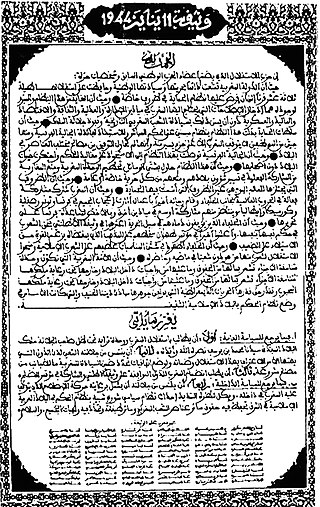
The Proclamation of Independence of Morocco, also translated as the Manifesto of Independence of Morocco or Proclamation of January 11, 1944, is a document in which Moroccan nationalists called for the independence of Morocco in its national entirety under Muhammad V Bin Yusuf, as well as the installment of a democratic, constitutional government to guarantee the rights of all segments of society. January 11 is an official government holiday in Morocco.
The Revolution of the King and the People was a Moroccan anti-colonial national liberation movement with the goal of ending the French and Spanish protectorates in Morocco in order to break free from colonial rule. The name refers to the coordination between the Moroccan monarch Sultan Mohammed V and the popular Moroccan Nationalist Movement in their efforts against colonialism and toward independence, particularly after the French authorities forced Sultan Mohammed V into exile on 20 August 1953. 20 August is considered a national holiday in Morocco, in remembrance of the Revolution of the King and the People. After Morocco had regained independence from the French, the movement effectively ceased to exist, as the Sultan managed to take control of the state. Meanwhile, the Moroccan Nationalist Movement was turned into an opposition party.
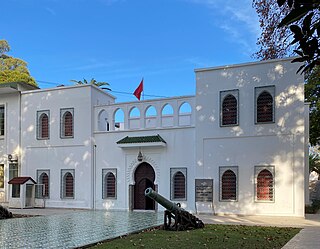
The Mendoubia or Mandubiyya refers to the former ceremonial mansion of the Mendoub, the representative of the Sultan of Morocco in the Tangier International Zone from 1924 to 1956. It now houses the commercial court of Tangier and a memorial museum.

The Mendoub or Mandub was a key official in the governance of the Tangier International Zone between 1925 and 1956, with a wartime interruption from 1940 to 1945.

On 22 October 1956, French forces hijacked a Moroccan civilian aircraft carrying leaders of the Algerian National Liberation Front (FLN) during the ongoing Algerian War. The Douglas DC-3 belonging to Royal Air Maroc was carrying Ahmed Ben Bella, Hocine Aït Ahmed, Mohamed Boudiaf, Mostefa Lacheraf, and Mohamed Khider. It was destined to leave from Palma de Mallorca for Tunis where the FLN leaders were to conference with Prime Minister Habib Bourguiba, but French forces intercepted the civilian aircraft over the Mediterranean Sea and redirected the flight to occupied Algiers, where the FLN leaders were arrested, derailing the planned conference in Tunis. It's considered one of the most important events in the Algerian War.

The Abdelhafid Palace or Moulay Hafid Palace is a historic structure at 23, rue Mohammed Ben Abedelouhab in the Hasnouna neighborhood of Tangier, Morocco. It was built in 1912–1913 as the intended main residence of former Sultan Abdelhafid following his abdication, but was never used for that purpose. In 1927, it was purchased by Italy and subsequently renamed Palazzo Littorio, hosting various public institutions including schools and a hospital. In 1943 the Badoglio government had it renamed Casa d'Italia, and a few years later it became known as the Palace of the Italian Institutions. Even though it still houses various Italian-related activities and was renovated in the early 2000s, it has long been underutilized.

Dar Niaba refers both literally and metaphorically to the office of the Naib or representative of the Sultan of Morocco to the foreign communities in Tangier, under the Moroccan diplomatic arrangements in place from the 1840s to the Treaty of Fez that ended the country's sovereignty in 1912. The office of the Naib was maintained in a symbolic capacity until the creation in 1925 of the Tangier International Zone, when its last holder Mohammed Tazi became Tangier's Mendoub.
The Moroccan Nationalist Movement was an Arab nationalist and Pan-Arabist political movement in Morocco that opposed the French protectorate. It was nominally led by the Moroccan sultan Mohammed bin Youssef. Most of its leaders were from the Istiqlal Party.